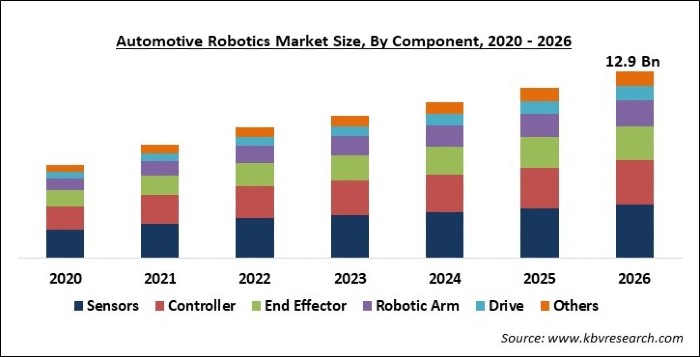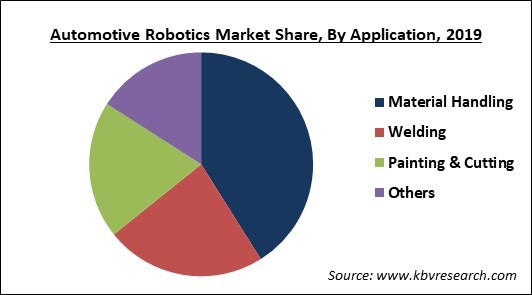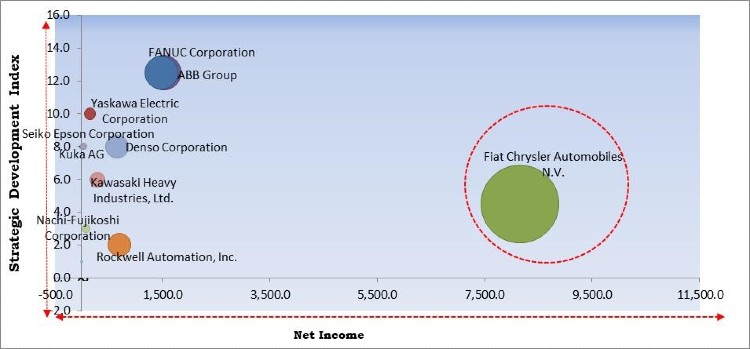
Global Automotive Robotics Market By Type (Articulated, Cartesian, Cylindrical, SCARA, and Others), By Component (Robotic Arm, End Effector, Sensors, Controller, Drive and Others), By Application (Material Handling, Welding, Painting & Cutting and Others), By Region, Industry Analysis and Forecast, 2020 - 2026
Special Offering:Industry Insights | Market Trends | Highest number of Tables | 24/7 Analyst Support
Get in-depth analysis of the COVID-19 impact on the Automotive Robotics Market
Market Report Description
The Global Automotive Robotics Market size is expected to reach $12.9 billion by 2026, rising at a market growth of 12.3% CAGR during the forecast period. Robotics refers to a multidisciplinary branch of science and engineering that include computer, mechanical, electrical science and other engineering streams. Robotics helps in the design, construction, operation, and usage of robot. Moreover, advancement in robotics technology is used to develop machines that can replace people.
Robotics finds its application in various segments such as commercial andhousehold robots. The commercial robots are utilized in many industries such as automotive, military, medical, agriculture and among others. Application of robotics is majorly in the automotive industry. In different kind of automotive robotics products, articulated robots procure major share in automotive robotics market. However, robotic controller component is becoming a profitable element that pushes the automotive robotics market in the forthcoming years.
对汽车的需求不断上升average income, as a result, automotive industry became the one of the most thriving industries across the globe. The leading players of the industry are renowned companies who have proved their prominence across the globe. Therefore, growth of the automotive sector is directly proportional to the growth of automotive robotics market. The demand for robots in the automotive industry is pushed by many factors. These include modernization in the leading automobile manufacturing regions like US, Russia, Germany, India, China, and Japan, huge investments in the manufacturing capacity of new or modern automotive product line in evolving market. The market is also driven by the rising need to reduce product launch time, growing need of alternative source for untrained labor or eliminating issue of increasing labor costs, and high demand for accuracy and quality control.

By Component
Based on Component, the market is segmented into Robotic Arm, End Effector, Sensors, Controller, Drive and Others. On the basis of component,robotic sensorssegment procured the highest revenue share of the automotive robotics market. The primary factor behind this is the extra capabilities that are brought into the automotive robots because of these sensors. These sensors-integrated robots can take intelligent decisions regarding manufacturing process, and thereby making the process much simpler and less time-consuming. Some of the main sensory systems utilized in automotive robotics are vision perception sensors and force sensing.
By Type
基于类型,市场划分为Articulated, Cartesian, Cylindrical, SCARA, and Others. Articulated robots are expected to garner major revenue share of automotive robotics market during the forecast years. Moreover, the use of articulated robots is boosted by its increase utilization in material handling, welding, and material removal and dispensing. They have generally four to six axes but with modern technologies and development, it may go on to ten axes, create them more versatile. This, as a result, improves the productivity of company through superior precision and speed. The prices of these products are reducing due to its higher shelf life.

By Application
Based on Application, the market is segmented into Material Handling, Welding, Painting & Cutting and Others. Material handling segment held the major revenue share of the Automotive Robotics Market. Robots are used in automobile production plants primarily for tasks like painting, and spot welding. Also, there are emerging opportunities for using robots throughout the supply chain to grow productivity. Furthermore, robots don’t feel tired and hence, the manufacturing processes are consistent throughout the day and consistency remains the same in peak production rates.
| Report Attribute | Details |
|---|---|
| Market size value in 2019 | USD 6.6 Billion |
| Market size forecast in 2026 | USD 12.9 Billion |
| Base Year | 2019 |
| Historical Period | 2016 to 2018 |
| Forecast Period | 2020 to 2026 |
| Revenue Growth Rate | CAGR of 12.3% from 2020 to 2026 |
| Number of Pages | 259 |
| Number of Tables | 414 |
| Report coverage | Market Trends, Revenue Estimation and Forecast, Segmentation Analysis, Regional and Country Breakdown, Companies Strategic Developments, Company Profiling, Competitive Analysis |
| Segments covered | Type, Component, Application, Region |
| Country scope | US, Canada, Mexico, Germany, UK, France, Russia, Spain, Italy, China, Japan, India, South Korea, Singapore, Malaysia, Brazil, Argentina, UAE, Saudi Arabia, South Africa, Nigeria |
| Growth Drivers |
|
| Restraints |
|
Free Valuable Insights:Global Automotive Robotics Market to reach a market size of $12.9 billion by 2026
By Region
基于区域,市场划分为也th America, Europe, Asia Pacific, and Latin America, Middle East & Africa. Asia-Pacific is anticipated to garner highest market share over the forecast years followed by Europe, North America, and LAMEA. Moreover, LAMEA is expected to witness highest growth rate due to rising acceptance of industrial robots in automotive companies in the next few years.
KBV Cardinal Matrix - Automotive Robotics Market Competition Analysis

The major strategies followed by the market participants are Product Launches and Partnerships. Based on the Analysis presented in the Cardinal matrix; Fiat Chrysler Automotive N.V. is the major forerunner in the Automotive Robotics Market. Companies such as FANUC Corporation, ABB Group, Yaskawa Electric Corporation, Seiko Epson Corporation, Kuka AG, Denso Corporation, Kawasaki Heavy Industries, Ltd., and Rockwell Automation, Inc. are some of the key innovators in the market.
The market research report covers the analysis of key stake holders of the market. Key companies profiled in the report include ABB Group, Kuka AG, FANUC Corporation, Yaskawa Electric Corporation, Denso Corporation (Denso Wave, Incorporated), Rockwell Automation, Inc., Seiko Epson Corporation, Kawasaki Heavy Industries, Ltd., Fiat Chrysler Automobiles N.V. (Comau S.P.A) and Nachi-Fujikoshi Corporation.
Recent Strategies Deployed in Automotive Robotics Market
» Partnerships, Collaborations, and Agreements:
- Oct-2020: ABB collaborated with Volkswagen Commercial Vehicles. Under this collaboration, ABB received an order of 800 industrial robots for supporting the production of the latest generation of electric vehicles at Volkswagen's plant in Hannover, Germany.
- Oct-2020: Yaskawa partnered with Lorch Welding Systems, one of the technology leaders in the field of MIG-MAG welding. The partnership focused on providing new innovative solutions to industrial companies in the welding sector. It also helps in creating joint solutions that allow customers to further automate their production and to further increase their competitiveness.
- Oct-2020: Rockwell Automation signed a five-year partnership with Microsoft Corporation. Under this partnership, the companies integrated each company's expertise in the industrial and IT markets, respectively, teams work together more seamlessly, allowing industrial organizations to save on infrastructure costs, speed time-to-value, and increase productivity.
- Aug-2020: FANUC entered into a partnership with Deep Learning Robotics Ltd., a leading technology company in the field of autonomous robotic learning. Under this partnership, Deep Learning Robotics established compatibility between its state-of-the-art smart robot learning controller and FANUC's industrial robots and ran a proof of concept application through FANUC's collaborative robots.
- Jul-2020: Fiat Chrysler came into partnership with Waymo, an American autonomous driving technology development company. In this partnership, FCA combined its software, computers, and sensors into Ram commercial vans for use by the new Waymo through autonomous logistics service.
- May-2020: Comau collaborated with Exechon, a Sweden based Technology Company. The collaboration aimed to design and produce a new Comau machining center that can handle lightweight framing and structural components for multiple sectors with a particular focus on automotive, aerospace, and electrification.
- Apr-2020: KUKA came into an agreement with BMW AG, the Munich-based automotive company. In this agreement, KUKA aimed to supply around 5,000 robots for BMW's new production lines and factories. KUKA's robot models are used primarily in body-in-white production and other technologies.
- Apr-2020: Denso entered into a partnership with the Tokyo Institute of Technology. Under this agreement, the companies jointly established Denso Mobility Collaborative Research Center to boost their joint research and make coordinated efforts to conduct comprehensive research in a broad range of fields at the Collaborative Research Cluster.
- Feb-2020: FANUC signed an agreement with BMW AG, the automotive company. Under this agreement, FANUC agreed to supply 3,500 robots for new production lines and plants. These robots are used in the production of current and future generations of BMW models.
- Nov-2019: Epson Robots joined hands with RND Automation, a leader in robotics. Following this collaboration, RND Automation uses Epson robots for its Hydraulic Valve Assembly Machine.
» Acquisition and Mergers:
- Apr-2019: Yaskawa acquired the ZF Italia's Factory Automation business unit in Assago. This acquisition strengthened Yaskawa's presence in the Italian market. It also merged the drive technology, controls, and robotics product lines to help better support the potential of their overall industrial automation portfolio.
- Sep-2018: ABB took over AB Rotech, robotic welding solutions, and services provider. This acquisition helped ABB to boost its robotic welding solutions for all tiers in the growing automotive segment.
- May-2016: ABB completed the acquisition of SVIA, a leading provider of automation cells for machine tending. The acquisition helped ABB to expand its robotics operations.
» Product Launches and Product Expansion:
- Oct-2020: Kuka introduced a new range of SCARA robots. The latest KR SCARA jointed-arm robots are reliable assistants for industrial production that excel in applications like small parts assembly, materials handling, and inspection tasks. It is ultra-compact and also offers maximum cost-effectiveness.
- Aug-2020: FANUC introduced a new extremely compact robot, M-10iD/16S. This new robot is the most compact model of the M-10iD series. M-10iD/16S robot is especially made for compact workspaces; this highly versatile robot can also be used for top mount applications.
- Aug-2020: Epson Robots launched the new and improved LS3-B SCARA and LS20-B SCARA robots. These robots consist of new and improved features include a batteryless encoder, a lower cable duct profile that is perfect for hard to reach work cell layouts, a built-in camera cable for easy vision system setup, and a new top-of-arm layout for enhanced usability.
- Apr-2020: Yaskawa launched the MOTOMAN-GP300R, a new multi-purpose robot in the MOTOMAN-GP series. This new MOTOMAN-GP300R contributes in building next-generation production lines that pursue high added value for customers.
- Feb-2019: Kawasaki introduced Collaborative Dual-Arm SCARA Robot, duAro2. The new addition added to its line of collaborative robots features an increased vertical stroke and payload capacity, making it the ideal choice for a broad range of applications. DuAro robots are a cost-effective robotic solution for assembly, material handling, inspection, machine tending, and dispensing applications.
» Geographical Expansions:
- Dec-2020: Fiat Chrysler Automobiles expanded its geographical footprint by setting up a global digital hub in Hyderabad. The hub is considered to be the automotive giant’s largest innovation and technology facility outside North America and EMEA regions.
- Jul-2020: ABB opened a new robotics facility in India. The new ABB Robotics facility allows its customers to take the benefits of Industry 4.0. These benefits include cutting-edge robotics and digitalization technologies, helping India to become a resilient high-tech manufacturing economy in the world.
- Oct-2019: FANUC established its new 461,000 square-feet North Campus robotics and automation facility in Auburn Hills. This new facility houses have many departments including engineering, product development, manufacturing, and warehousing.
Scope of the Study
Market Segments Covered in the Report:
By Type
- Articulated
- Cartesian
- Cylindrical
- SCARA
- Others
By Component
- Robotic Arm
- End Effector
- Sensors
- Controller
- Drive
- Others
By Application
- Material Handling
- Welding
- Painting & Cutting
- Others
By Geography
- North America
- US
- Canada
- Mexico
- Rest of North America
- Europe
- Germany
- UK
- France
- Russia
- Spain
- Italy
- Rest of Europe
- Asia Pacific
- China
- Japan
- India
- South Korea
- Singapore
- Malaysia
- Rest of Asia Pacific
- LAMEA
- Brazil
- Argentina
- UAE
- Saudi Arabia
- South Africa
- Nigeria
- Rest of LAMEA
Companies Profiled
- ABB Group
- Kuka AG
- FANUC Corporation
- Yaskawa Electric Corporation
- Denso Corporation (Denso Wave, Incorporated)
- Rockwell Automation, Inc.
- Seiko Epson Corporation
- Kawasaki Heavy Industries, Ltd.
- Fiat Chrysler Automobiles N.V. (Comau S.P.A)
- Nachi-Fujikoshi Corporation
Unique Offerings from KBV Research
- Exhaustive coverage
- The highest number of market tables and figures
- Subscription-based model available
- 保证最好的价格
- Assured post sales research support with 10% customization free
Automotive Robotics Market Related Reports:
Q1.
How valuable the automotive robotics market be in the future?
The global automotive robotics market size is expected to reach $12.9 billion by 2026.
Q2.
What are the key factors that drive automotive robotics industry?
There are several reason that cause high demand of this market one of them is rising automation in automotive industry.
Q3.
Who are the leading players in automotive robotics market?
ABB Group, Kuka AG, FANUC Corporation, Yaskawa Electric Corporation, Denso Corporation (Denso Wave, Incorporated), Rockwell Automation, Inc., Seiko Epson Corporation, Kawasaki Heavy Industries, Ltd., Fiat Chrysler Automobiles N.V. (Comau S.P.A) and Nachi-Fujikoshi Corporation.
Q4.
Which region dominated the automotive robotics market in 2019?
The Asia Pacific market dominated the Global Automotive Robotics Market by Region in 2019.
Q5.
At what CAGR is the automotive robotics market estimate to grow in the forecast period?
The expected CAGR of automotive robotics market is 12.3% from 2020 to 2026.
